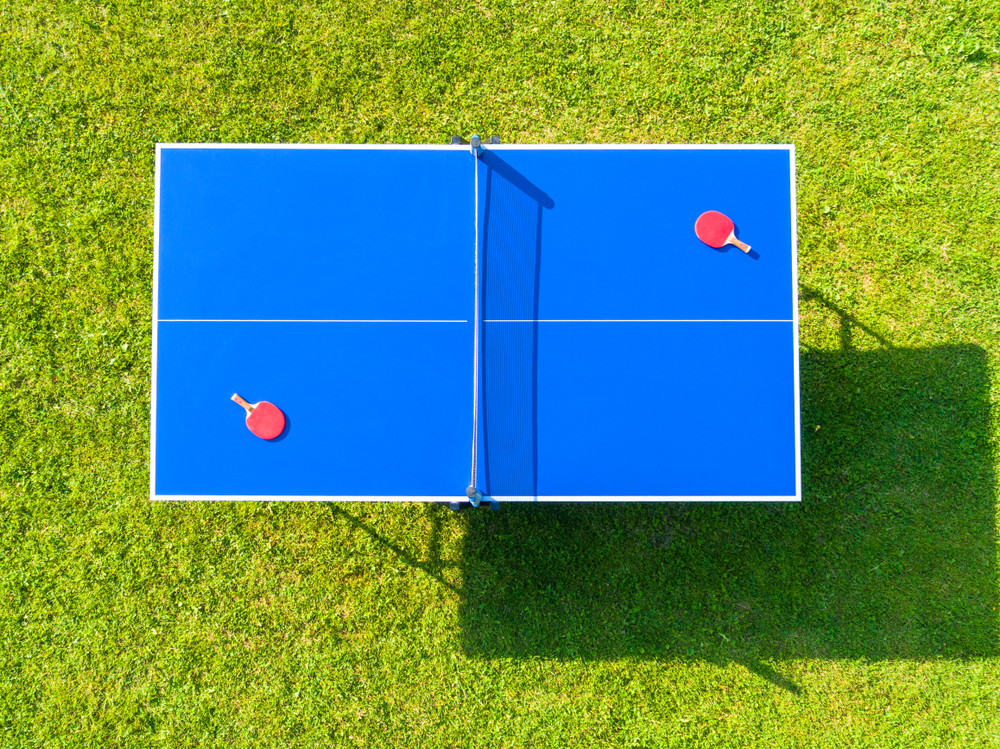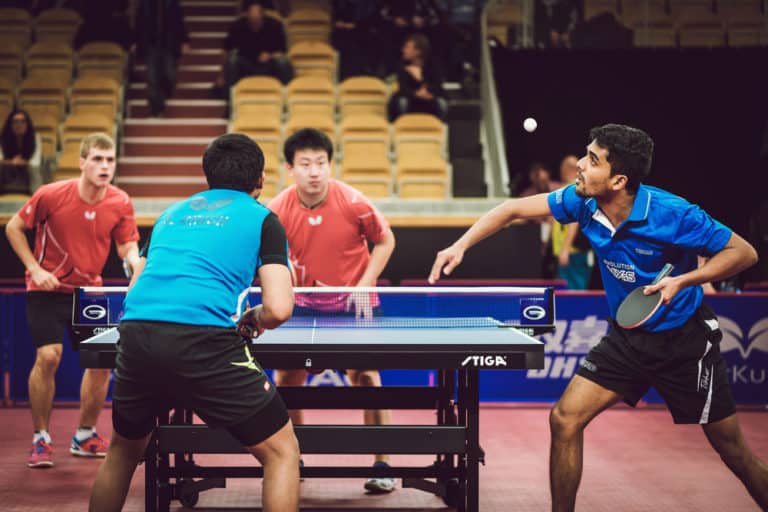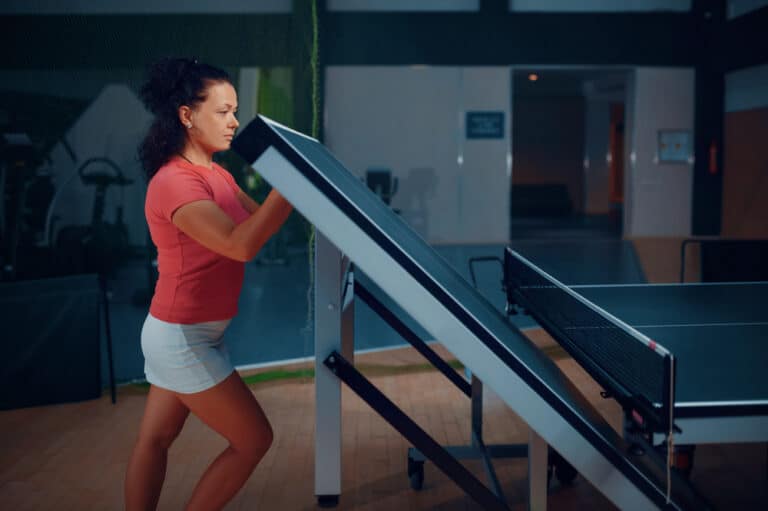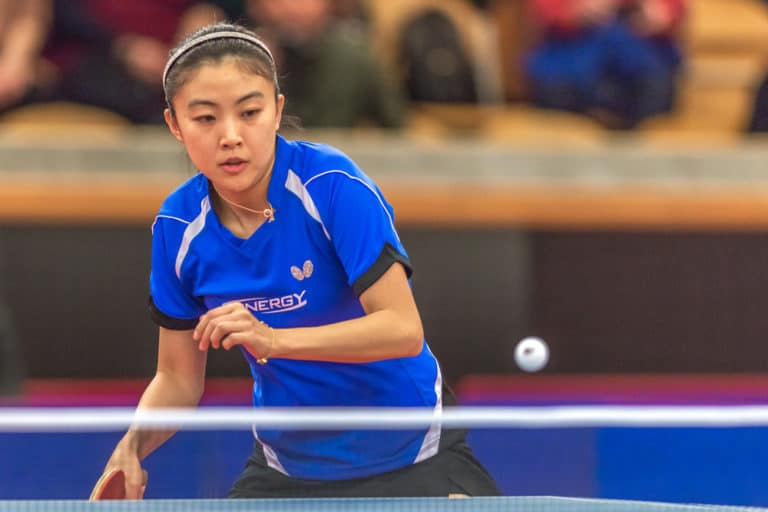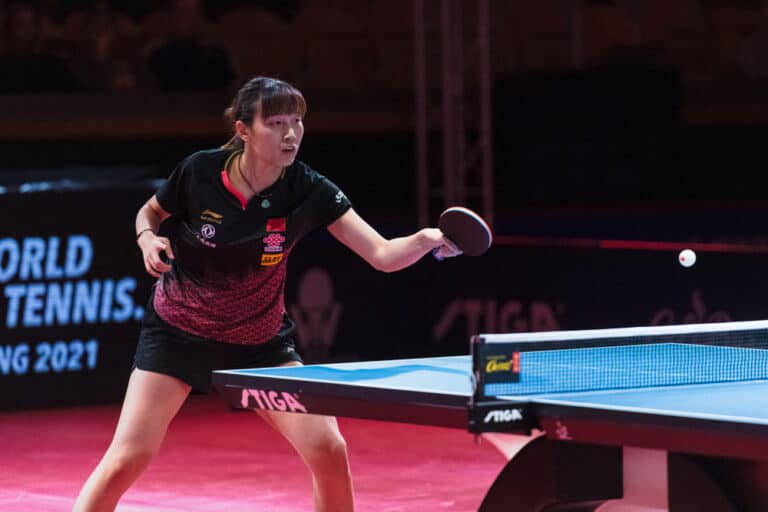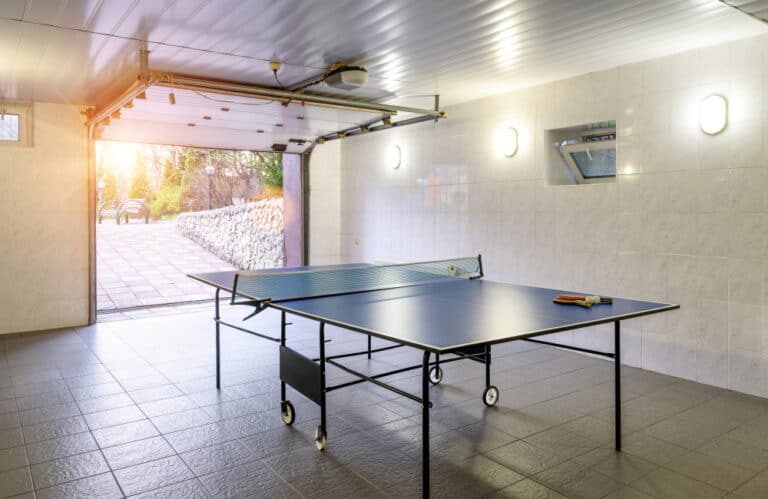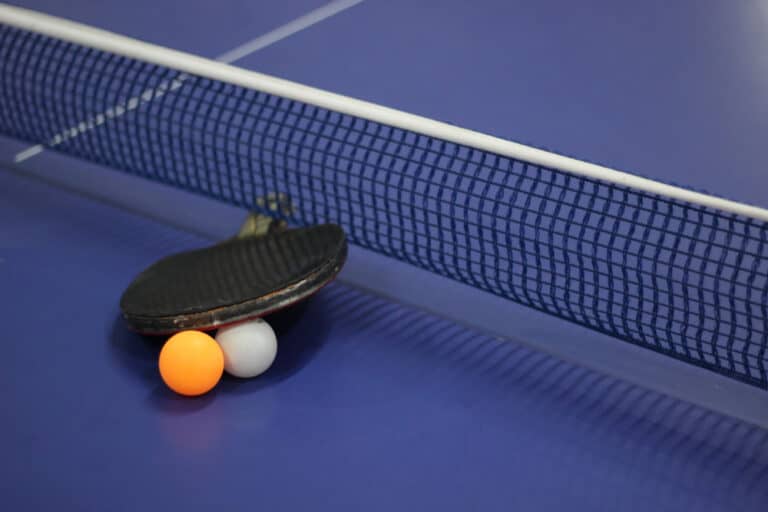What Color Should A Table Tennis Table Be?
When I watched table tennis at the Olympic Games, I noticed that the color of the table has been different in each edition. Even though the color of the tables was similar across the years, I was still able to clearly notice a difference. That made me wonder whether there were any specific rules as to what color a table tennis table should be.
Table tennis tournament tables are usually green or blue but must be a uniform dark color with a matt finish. The dark color makes it easier to see the ball. The matt finish prevents any color from shedding onto the ball under the tournament lights so the television cameras can pick up the ball.
Let’s take a closer look at what the regulations are about table tennis table color and how much freedom tournament organizers have over the choice of table color.
What Color Should A Table Tennis Table Be
If we look at the official rule book of the ITTF, there is no specific limitation of what color a table tennis table must be. Because table tennis is usually played with a white ball, the restrictions placed on the color of the table are to make the ball more visible against the surface of the table.
Therefore the rules state that the playing surface must be uniformly dark colored and have a matt finish. There must be a white side line, 2cm wide, along all four edges of the table.
The reason for the matt finish is to take off the shine from the table so that players are not blinded or distracted by light reflecting from the surface of the table. Another reason to minimize reflection off the table is that it makes televising the games more difficult if the cameras are picking up glare from the table surface.
When I played competitive table tennis at high school the tables we used were nearly always green, though we did occasionally play on black tables. The tournaments I watch these days mostly use blue tables.
A couple of years ago I got to play on the public tables in various parks in both Barcelona and Granada. The tables were made of concrete that had been stained dark green. The tables in Barcelona were in the shade of surrounding trees and had maintained their dark color. However, the tables in Granada had been exposed to years of harsh Spanish sunshine and were completely sun-bleached.
Have The Color Of Table Tennis Tables At The Olympics Always Been The Same
The table tennis tables used at the Olympics have not always been the same – even though the same rules for the permitted color have been used at each edition of the Olympics. The tables used at the Olympics are always a uniform dark color with a matt finish. Within this limitation, each successive Olympic host is able to use a color that fits in with the branding of that specific edition of the Olympics.
By way of example, the tables used at the 2012 London Olympics were a deep navy blue while those used at both the 2016 Rio Olympics and the 2020 Tokyo Olympics were more of an aquamarine shade of blue, though the exact shade of aquamarine blue was slightly different. By way of contrast, in the 2008 Beijing Olympics, the tables had a purplish tinge. Even though the exact color of the tables was different at each edition of the Olympic games, they were all within the rules as they were all a uniform dark color with a matt finish.
The tables used at the 2020 Tokyo Olympics were an aquamarine shade of blue as were the tables at the 2016 Rio Olympics. However, the shade of aquamarine was slightly different. The tables used at the 2012 London Olympics were a deep navy blue while those used at the 2008 Beijing Olympics, the tables had a purplish tinge.
What Is The Official Color Code For The Table Of Table Tennis?
Even though the ITTF rule book only limits table tennis tables to be a uniform dark color with a matt finish, I decided to dig into the origins of the preferred colors for table tennis tables, both in terms of what was used before and currently.
As I mentioned earlier, when I played competitively during the 1980s all our competition tables were dark green with a matte finish. The reason why green was the preferred color at the time was that it closely resembled the color of tennis courts at the time. In those days, concrete tennis courts were painted green to resemble grass as tennis was called by its full name of lawn tennis. Therefore, the color lawn-green was the preferred color for tennis courts and consequently table tennis tables.
Indoor tennis courts evolved to start using a blue surface as it tended to work better with the intensely bright artificial lights, making the ball more visible to the television cameras. Table tennis followed the example set by tennis and adopted the same blue for tournament tables as they were used indoors under the same intensity of artificial light.
The bright lights make it easier for the cameras to pick up the white of a table tennis ball against the dark matt blue of the table no matter how fast it is moving.
The current shade of blue used for table tennis tables also gives sufficient contrast for the red and black sides of the tournament standard table tennis bat making it easier to see when a player spins the bat in their hand. However, even with the surface color of the table tennis table I still can’t see when Timo Boll switches his bat from his left hand to his right in real-time. I have to wait for the slow-motion replay.
What Ping Pong/Table Tennis Tables Are Used In The Olympics?
The table tennis tables used at the Olympics have the same dimensions as all other regulation tournament tables. They are 9ft long, 5ft wide, and 30 inches high.
Even though most standard tournament-level tables are the same dark blue color with a matte finish, the rules of table tennis do not specify a color that must be used. In theory, this gives the organizers of each Olympic games the leeway/scope to change the color of their table tennis tables to something that fits the color scheme/branding of that specific Olympic games edition.
By way of example, the tables used at the 2012 London Olympics were a deep navy blue while those used at both the 2016 Rio Olympics and the 2020 Tokyo Olympics were more of an aquamarine shade of blue, though the exact shade of aquamarine blue was slightly different. By way of contrast, in the 2008 Beijing Olympics, the tables had a purplish tinge. Even though the exact color of the tables was different at each edition of the Olympic games, they were all within the rules as they were all a uniform dark color with a matt finish.
Are Olympic Table Tennis Tables Smaller?
When I first started watching table tennis at the Olympic Games I mistakenly thought that the tables looked smaller than the ones that I used when I played during the 1980s. Logically, I knew that the Olympics wouldn’t force players to use tables that were a different size to the standard 9ft by 5ft by 30 inches tournament table. It took me a while, but I eventually realized why the table was looking smaller to me.
It wasn’t that the table was smaller, it was the playing area around the table was much larger than I used in the 1980s. Back then, our tables were in the center of a playing area that was 17ft long and 11ft wide. Professional tournaments and the Olympics place their table tennis tables in the center of a playing area that measures 46ft long and 23ft wide.
In other words, I used a playing area of 187 sq ft, while at the Olympics they have a playing area of 1058 sq ft. That is a massive difference and what makes the tables at the Olympics look so small in the center of such a large playing area.
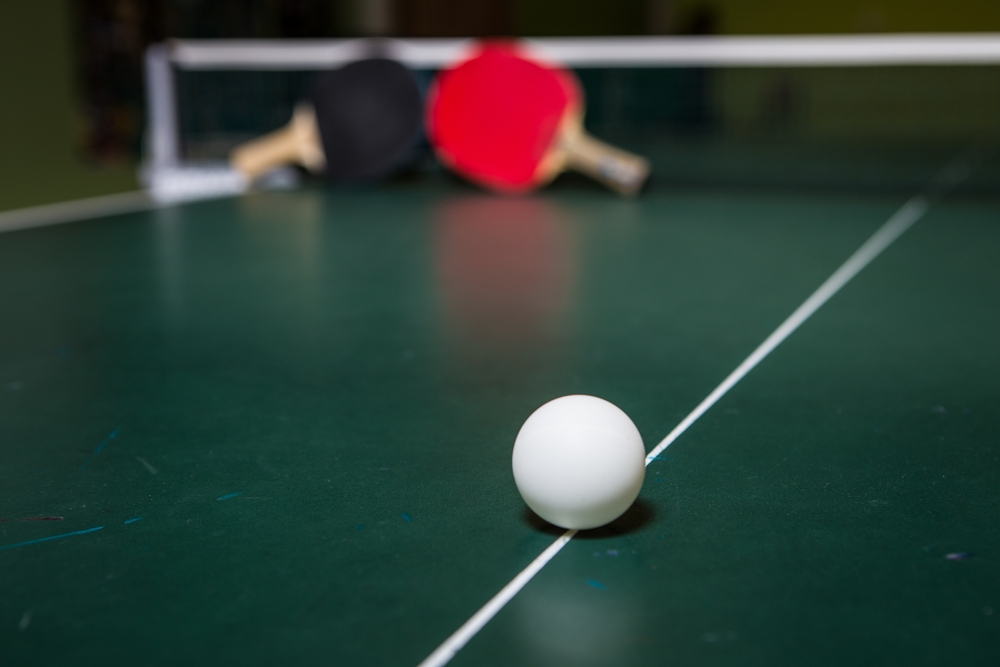
What Size Table Do The Table Tennis Pros Use In Their Tournaments?
The table tennis tables used in professional tournaments are the same regulation size that is used in all table tennis matches at amateur and recreational levels.
The key difference between the tables used in top-tier professional tournaments and the tables used recreationally is that the professional-level tables are heavier and more sturdy so that they won’t move easily if bumped by a player’s leg during a game.
The reason why professional tables appear to be a different size to the casual observer is that professional tournaments allow a much larger area of space around the table for the players to move.
What Is The Best Surface For A Table Tennis Table?
Table tennis tables use particle boards to create a table-like sound and feel. Ideally, a medium-density particle board should be used that has a higher percentage of resin. Medium-density particle board gives a consistent bounce and is more warp-resistant.
When it comes to the thickness of the tabletop, these generally range between half an inch and an inch. However, table tops that are less than a three-quarter inch in thickness are prone to warping over time.
Most table tennis tables on the market have a wooden playing surface covered by a minimum of 2 pigmented coats and a protective UV-resistant finish. Even though there is a UV-resistant coating, these tables are intended for indoor use only. The UV coating prevents the pigmented coatings from fading. If wood-surface tables are used outside, the extremes of heat and moisture will warp and degrade the table.
Tables intended for outside use still have the same particle board, though thinner. The particle board is sealed inside an aluminum outer shell. Aluminum-shell table tennis tables are completely weather-proof and are ideal for outdoor use.
When it comes to tournament play, the table surface is tested to see if it has the correct bounce height. A table tennis ball is dropped from a height of 300mm and needs to bounce to exactly 210mm for the table to be “certified true bounce”. A table that doesn’t have a certified true bounce can still be used recreationally, but serious players won’t use it for training.
The other, less common, type of playing surface is what you find in the public parks of larger cities. These table tennis tables are permanent fixtures and are made from solid concrete. It must be noted that the concrete tables used in public parks are for recreational use and not serious tournament play. The nature of concrete will cause a ball to bounce higher than a particle board table, so concrete tables are not “certified true bounce” tables.
What Is The Surface Of A Table Tennis Table Made Of?
There was a time when table tennis tables were made almost exclusively from compressed plywood. However, these tabletops were prone to warping over time.
These days, better quality table tennis tables are made from a medium-density fiberboard that has a higher percentage of resin. These tabletops are more warp-resistant, durable, and give a truer bounce over their entire surface area.
The fiberboard tabletop is coated in 2 layers of a pigmented coat with a third, UV-resistant coat added over the top. This gives the table tennis table a more natural feel than the plasticky melamine surface used on many recreational tables for its added durability.
What Is The Best Colour For A Table Tennis Table?
The two most popular colors for table tennis tables are darker shades of green and blue. Of these, blue tabletops allow a better vision of the ball (either white or yellow).
When it comes to professional tournaments, they are almost exclusively played on blue tables as they make it easier for the ball to be picked up by television cameras.
It is important that the table has a matt finish and does not reflect/shed any color onto the ball or else the ball becomes more difficult for the players to see and near-impossible for the cameras to pick up.
What Color Are Professional Ping Pong Tables?
The ITTF tournament tables are generally either green or blue, though can be in different shades of those colors, but must still conform to the rules of being a uniform dark color in a matt finish so that they do not shed any color onto the ball.
If the color of the table sheds onto the ball it becomes near impossible for the ball to be picked up by television cameras.

